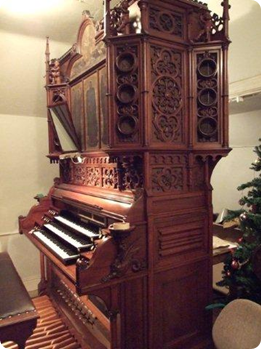(Pump organs)

3 manual harmonium with pedal by K.A. Andersson, Stockholm, 1890s. Foto: Mats Ernvik.
Harmoniums or pump organs have small vibrating brass reeds, which are set in motion as air passes through them. Accordions and harmonicas form the tone in the same way and are thus relatives of the pedal organs.
There are two principles for how the air causes these reeds to sound. The European system uses air blown past the reeds, while the American system goes the opposite way with air sucked through the reeds (vacuum). The American design is easier to build and manufacture, and the instruments have a softer sound compared to the European harmoniums. The air supply is generally produced through two treadles pumped by the player.
Pump organs were built in many different designs from those that had a single register (set of reeds) to larger organs with 2-3 manuals and pedal and even up to 30 registers. They are sometimes also named for their prevalent use e.g. school organs (particularly in Sweden), chamber organs, home organs, desk organs, salon organs, chapel organs.
They have also been popular both as concert organs and practice organs for future organists.